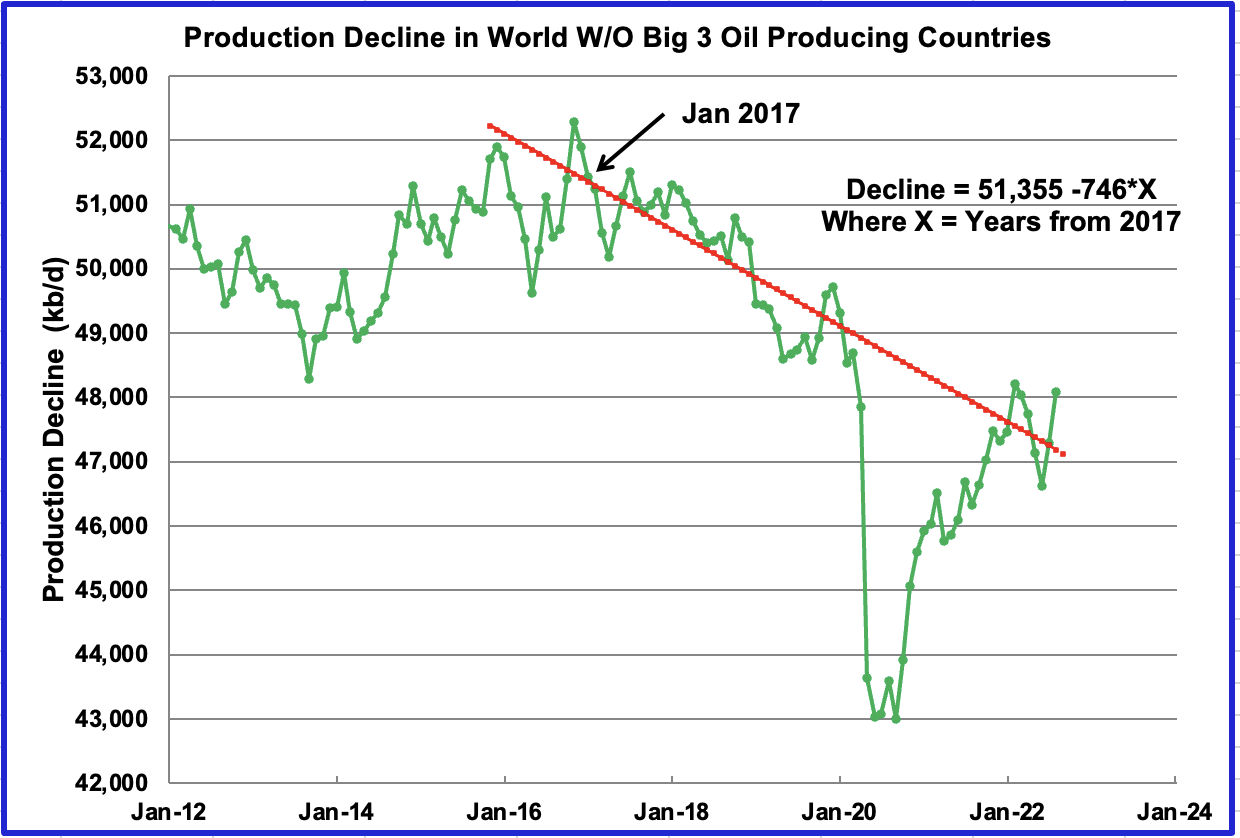Global net oil export mathematics, part 7: Some final notes
"I think overall we could be down to half of our oil that we produce today by 2035."
(From Derrick Jensen's interview with Alice Friedemann (she is the one who operates the blog "Energy Skeptic") one year ago, titled "Alice Friedemann—Life After Fossil Fuels book—Derrick Jensen Resistance Radio 2021-09-05")
This is confirmed by Steve St. Angelo at SrsRocco Report:
IT’S OFFICIAL U.S. SHALE OIL BOOM IS NOW OVER: Shale Oil Production To Collapse 50-75% By 2035 (November 27, 2022)
* * *
The following graph and text is from the blogpost "Permian Pushes US September Oil Production to Post-Pandemic High" 12/02/2022 on the blog "Peak Oil Barrel":

"This chart shows the production decline in the world without the Big 3, US, Russia and Saudi Arabia over the period January 2017 to August 2022. February 2020 to September 2021 was left out of the analysis for the OLS line. The annual decline rate is 746 kb/d/yr."
__________________________________________________
746 kb/d/yr is a decline rate of about 1,43 % per year. I think this chart shows crude + condensate (as it does in the other charts in the blogpost), which also counts shale oil. Conventional oil alone declines a little faster, let's say 1,5 % every year. All countries/crude + condensate have a slower decline rate, maybe 1 % per year since November 2018. All countries/only conventional oil, have an estimated decline rate of 1,3 %. This decline rate increases for every year, starts with 1,3% in 2018, and ends with an estimated decline rate of 6 % in 2028 (it will probably increase exponentially, because of the imminent collapse of civilization and the subsequent collapse of the oil industry), 10 years later, by then we will lose about 4 mbd (million barrels per day) of oil per year [of crude+condensate, not “All Liquids]). For the whole period 2018-2028 the average decline rate is at least an estimated 2,5 %, so my estimate in part 6 of this series of a 2,5 % decline rate for every year is more than justified, it is perhaps the minimum average decline rate that is possible for the period. These calculations are also in harmony with Alice Friedemann’s calculations above. If Alice is correct, the decline rate in 2035 has to be somewhere between 8-10 mbd per year, a situation where the global oil industry will be able to only marginally offset the natural decline rate of oil production, which by then will be about 14 mbd per year (see the calculations below). Still we have to find and bring into production at least a new Ghawar (the world's largest oil field, in Saudi Arabia, pumped once about 5 mbd) every year in order to keep the decline rate at 8-10 mbd/per year. Alice Friedemann also says in the radio interview above on youtube that "80 % of oil production is declining at 8,5 % a year", which means a decline of about 8,7 mbd/per year of oil (counting “All Liquids”). This was over one year ago, and Alice also says in the same video, that "the rate of decline (of oil) keeps increasing exponentially. On top of that we haven't hardly found much oil in the past 7 years."
World oil production have an estimated natural decline rate (the decline rate if no new exploration is undertaken and no new wells are drilled) of 10,5 mbd per year during the years 2015-2025, according to Steve St. Angelo's calculations on the blog “SrsRocco Report”. During the years 2025-2035 the figure is estimated to be at least 14 mbd per year, extrapolating from trends since 1965 (see the youtubevideo "Oil Prices Will Never Crash Again now That OPEC is in the Drivers Seat as Shale Dies" from 3.12.2022, 14.00 minutes into the video). This means that in 2028, which is my calculated end point for oil exports, 10 million barrels of oil from newfound oil and new oil wells has to be produced just to stay at the 6 % a year decline rate which I calculated for 2028. If we produce less new oil, the decline rate will increase. But I think they could manage that, if they really make a mighty effort. But it means that they have to bring into production about as much as Russia produces, every year, 10 mbd every year.
If we want to keep the yearly decline rate at even lower levels than 6 % in 2028, say at 3 or 4 %, we have to bring into production even more, maybe as much as US produces, every year (12,3 mbd). With a collapsing economy and a collapsing civilization, this just would require too much. I don't think it's feasible.
So, therefore I believe that my previous calculations in the earlier parts of this series are justified and confirmed by this blogpost.

